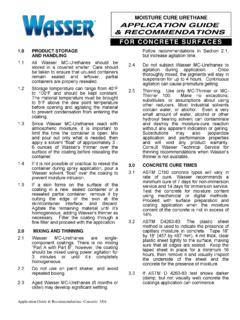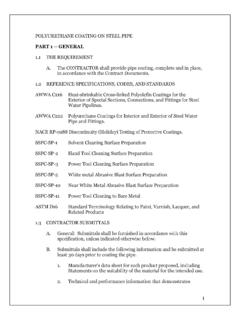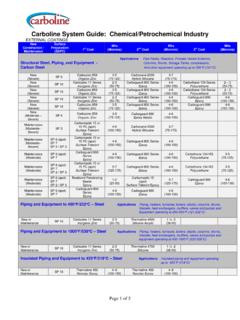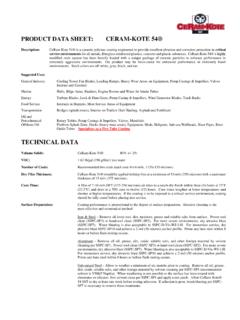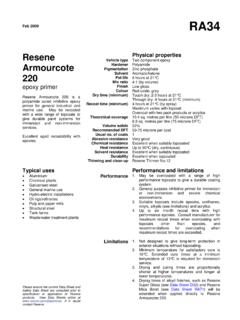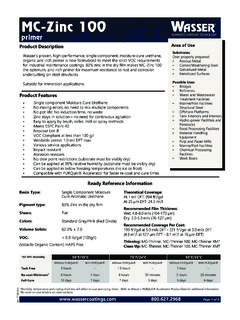Transcription of PAINT APPLICATION SPECIFICATION NO. 1 - Reli …
1 sspc -PA 1 April 1, 2000 sspc : The Society for Protective Coatings PAINT APPLICATION SPECIFICATION NO. 1 Shop, Field, and Maintenance Painting of Steel 1. Scope 1 .I This SPECIFICATION covers procedures for the PAINT - ing of steel surfaces. The scope of this SPECIFICATION is rather broad, covering both specific as well as general require- ments for the APPLICATION of PAINT . This SPECIFICATION does not provide detailed descriptions of surface preparation, pretreatments, or selection of primers and finish coats. This SPECIFICATION does provide detailed coverage of the proce- dures and methods for APPLICATION after the selection of the coating materials has been made. 2. Description This SPECIFICATION for shop, field, and maintenance painting is intended to be used for steel which, because of its exposure condition, will be subjected to corrosive attack, either from the weather or from the service environment, and where a high quality of cleaning and painting is essen- tial.
2 It is not contemplated that the requirements of this SPECIFICATION are necessary for the cleaning and painting of steel which will not be subjected to corrosive attack. The following is a summary of the major sections of this specifi- cation. 1. Scope 2. Description 3. Reference Standards 4. Definitions 5. Pre- APPLICATION Procedures Materials Handling and Use Surface Preparation Pretreatments Coating Materials Preparation Temperature Moisture Humidity Cover Defects Striping Continuity Thickness Recoating Tinting 1 Intercoat Adhesion Contact Surfaces Induction Time and Pot Life 6. Factors Affecting the APPLICATION of Coatings 7. APPLICATION Methods General Brush APPLICATION Roller APPLICATION Spray APPLICATION (General) Air Atomizing Spray APPLICATION Airless Spray APPLICATION Air-Assisted Airless APPLICATION Hot Air Spray APPLICATION Hot Airless Spray APPLICATION O Plural Component Spray APPLICATION 1 High Volume Low-Pressure Spray Applicability Number of Coats and Type of Coating Damage to Shop Coating Contact Surfaces Requirements for Welding Rust Preventive Compounds Erection Marks Applicability Surface Preparation Touch-up of Shop Coated Surfaces Field Coating Procedures Applicability Surface Preparation for Recoating Incompatibility Work to be Performed Coatings General Drying Oil Curing Coatings Vinyls and Chlorinated Rubber Coatings Bituminous Coatings Epoxy and Coal Tar Epoxy Coatings Zinc-Rich Coatings Urethane Coatings Waterborne
3 Thermoplastic Coatings 12. Curing and Handling of Coatings Drying of Coatings Handling of Coated Steel 8. Shop Coating 9. Field Coating 10. Repair of Damaged Intact Coatings 11. APPLICATION Procedures for Generic Groups of 13. Inspection 14. Safety and Environmental Concerns 15. Disclaimer 16. Notes Appendix A - Additional Reference Materials 488 COPYRIGHT The Society for Protective CoatingsLicensed by Information Handling ServicesCOPYRIGHT The Society for Protective CoatingsLicensed by Information Handling ServicesSSPC-PA 1 April 1, 2000 3. Reference Standards The standards referenced in this SPECIFICATION are listed in Sections through and form a part of this SPECIFICATION . The latest issue, revision, or amendment of the referenced standards in effect on the date of invitation to bid shall govern unless otherwise specified.
4 If there is a conflict between the requirements of any of the cited reference standards and this SPECIFICATION , the requirements of this SPECIFICATION shall prevail. sspc : THE SOCIETY FOR PROTECTIVE COAT- INGS STANDARDS: PA 2 Measurement of Dry Coating Thickness With Magnetic Gages PA Guide 3 A Guide to Safety in PAINT APPLICATION SP 1 Solvent Cleaning AMERICAN SOCIETY FOR TESTING AND MATE- RIALS (ASTM) STANDARDS: D 16 Terminology Relating to PAINT , Varnish, Lacquer, and Related Products D 4285 Method for Indicating Oil or Water in Compressed Air NACE INTERNATIONAL STANDARD: RPO178 Fabrication Details, Surface Finishing Re- quirements, and Proper Design Consider- ations for Tanks and Vessels to be Lined for Immersion Service 4. Definitions SHOP, FIELD AND MAINTENANCE COATING: The APPLICATION of coatings to steel surfaces whether in the shop or in the field.
5 PAINT : In the general sense, PAINT includes prim- ers, enamels, varnishes, emulsions, catalyzed coatings, bituminous coatings, and other organic coatings. Inorganic coatings which are also applied as liquid films are included in this definition. This definition is compatible with most commonly used industry glossaries. SHOP COATING: The surface preparation and coating of steel surfaces inside a shop or plant before shipment to the site of erection. FIELD COATING: The on-site coating of new or previously coated steel structures before or after erection. MAINTENANCE COATING: The coating of steel structures in service that have been previously coated and require touch-up or recoating. OMMENDATIONS: These (or similar terms) are used to refer to an equipment supplier s or coating manufacturer s latest published or written instructions and recommenda- MANUFACTURER S INSTRUCTIONS AND REC- tions.
6 Verbal recommendations or instructions from an equipment or coating manufacturer are not acceptable unless backed up in writing by the manufacturer s technical staff. 5. Pre- APPLICATION Procedures See Section 11 for procedures unique to specific generic coatings. MATERIALS HANDLING AND USE All coating shall be delivered to the shop or jobsite in original, unopened containers with labels intact. Minor damage to containers is acceptable provided the container has not been punctured or the lid seal broken. Each container of coating shall be clearly marked or labelled to show coating identification, date of manufac- ture, batch number, and other information as needed to meet regulatory requirements. Each type of coating shall be accompanied by the manufacturer s Material Safety Data Sheet (MSDS) and product data sheet containing information such as basic chemical composition, weather conditions acceptable for APPLICATION , and proper storing and mixing.
7 All containers of coating shall remain unopened until required for use. No more containers of coating shall be opened than will be applied that day. The label informa- tion shall be legible and shall be checked at the time of use. Coating which has livered, gelled, or otherwise deteriorated during storage shall not be used; however, thixotropic materials which can be stirred to attain normal consistency may be used. The oldest coating of each kind that is in accept- able condition shall be used first. In every case, coating is to be used before its shelf life has expired. Before using a coating which has exceeded its shelf life, the manufacturer shall verify its quality and then certify its use for a given period of time. Coatings shall be stored in original unopened containers in weathertight spaces where the temperature is maintained between 40 OF and 100 OF (4 OC and 38 OC) unless otherwise recommended in writing by the manufac- turer.
8 The coating temperature shall be brought to the manufacturer s written recommended APPLICATION tempera- ture before use. (See Note for more information on coating storage.) SURFACE PREPARATION The surface shall be cleaned as specified in the procurement documents. In no event shall the surface preparation be less than the PAINT manufacturer s recom- mendations for the intended service environment. The surface to be coated shall have the specified surface preparation at the time of APPLICATION of the coat- 489 COPYRIGHT The Society for Protective CoatingsLicensed by Information Handling ServicesCOPYRIGHT The Society for Protective CoatingsLicensed by Information Handling ServicesSSPC-PA 1 April 1, 2000 ing. If the surface is degraded or contaminated subsequent to surface preparation and prior to coating, the surface shall be restored to the specified condition before coating appli- cation (see Note ).
9 In order to control the degradation or contamina- tion of cleaned surfaces, the pretreatments, or, in the ab- sence of a pretreatment, the prime coat shall be applied as soon as possible after the surface has been cleaned and before degradation or contamination has occurred. Suc- ceeding coats shall be applied before contamination of any existing coating occurs. Previously applied coating shall be roughened prior to coating whenever necessary for the development of proper intercoat adhesion (see Section 1). Cleaning and coating shall be scheduled to mini- mize the amount of dust and other contaminants that may fall on newly applied wet coating films. Surfaces not in- tended to be coated shall be suitably protected from the effects of cleaning and coating operations. PRETREATMENTS When specified, the surface shall be pretreated prior to APPLICATION of the prime coat of coating.
10 The provisions of Sections and shall also apply to pretreated surfaces and the materials used for this purpose. When chemical pretreatments are used, sufficient time shall elapse between pretreatment and APPLICATION of the prime coat to permit any chemical action to be completed and the surface to dry. Two-component pretreatments shall be applied within the specified interval after mixing. When proprietary pretreatments are used, the instructions of the manufacturer shall be followed. Inhibitive water washes used to prevent rusting of cleaned surfaces prior to coating shall not be considered pretreatments. These may be used only if they do not adversely affect the long term performance of the coating and are specifically authorized. Test patches may be used to check adhesion of the coating prior to coating the entire surface.


